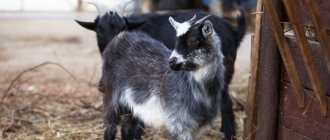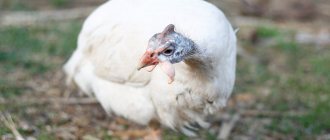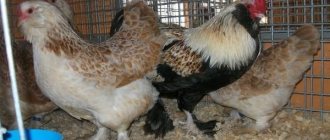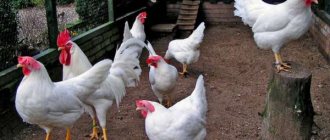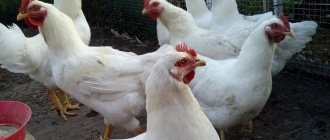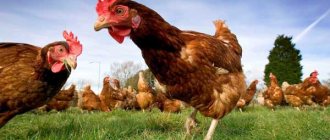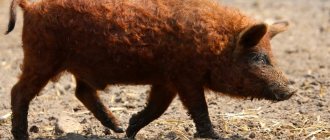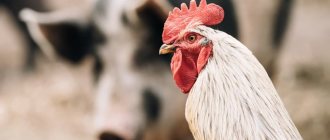Brahma chickens are distinguished by their calm nature and minimal demands on the conditions in the chicken coop, due to which they are often chosen for breeding by owners of private farmsteads and experienced poultry farmers of large farms. Such a bird will become a real decoration of the yard, and will also help you get a good profit from the sale of meat and eggs.
Pros and cons of the Brama breed
pros
- Great dual purpose chicken.
- Very friendly with children.
- Huge size and unique appearance.
- Lays eggs all winter.
Minuses
- It may take 7 months before installation begins.
- He eats a lot, so the food bill is higher than for other breeds.
- When they are hungry, they can intimidate their pack mates.
Chick care
Raising chickens in the first days of life is done carefully.
For 5 days after hatching, the babies require a constant temperature of +30°C. From the 5th day it drops to +29°C, from the 10th day - to +26°C. After 40 days of life, chickens live at +18°C. Daylight hours for babies last all 24 hours of the day.
The young animals are fed according to a certain scheme:
- 1-7 days: finely grated boiled eggs, finely chopped corn and wheat grits;
- from day 8, cottage cheese and greens from dandelion and nettle leaves, minced in a meat grinder, are added to the diet;
- after 7 days, fruits and vegetables are added;
- On day 28, beet tops are added.
It is recommended to vaccinate chickens according to the standard scheme, which your veterinarian will familiarize you with..
History of the breed
Brahma was first developed in the 1800s in China. The name Brahma comes from the Brahmaputra River in India.
Until the 1930s, Brahmas were one of the most popular chickens for meat due to their size. However, as industrial agriculture has grown, Brahmas have become an unfavorable species to breed as they can take up to two years to reach maturity.
Breeds that matured faster became more profitable for meat. Brahmas are steadily gaining popularity again, this time as backyard pets.
Owner reviews
Vladimir Telnov, Orenburg (real person, acquaintance):
I've been keeping this breed for three years now, and I'm happy with almost everything. First, he built a huge chicken coop for them. Then I realized that they didn’t need a large area. We clean them often, but the feathers still often get dirty and have to be trimmed. It’s a pity that there are few such lovers in our city, and there are few options for breeding.
Elena Voronova, Yegoryevsk (Fermilon website):
I bought the bram specifically for decorative purposes. I can’t use them for meat. There are three extra roosters and no one to sell them to. I thought they would fight, but they live very peacefully. So they walk around the yard together.
Breeding and maintaining brahms is a fascinating activity. These chickens are really very beautiful, delighting owners and guests with their appearance. And at the same time, delicious eggs are laid all year round, so there are tangible benefits from beauty.
- Author: Burdygin Sergey Ivanovich
Rate this article:
- 5
- 4
- 3
- 2
- 1
(8 votes, average: 2.4 out of 5)
Share with your friends!
Breed varieties
In the description, Brahma chickens are classified as Asian chickens. The breed is classified according to its distinctive feather patterns:
- Light Brahma, white with a gray tint. They have black stripes on their saddle feathers. They were first officially recognized in 1865.
- Dark Brahma has noticeable differences between male and female. The male has a black body, chest and tail. Its feathers and saddle are striped black and white. The female has a gray body, chest, back and wings. It is covered with white and light gray shade. They were also first recognized in 1865.
- Buff Brahma has the same pattern as Light Brahma, except its color is a pale orange-brown. It was first recognized in 1924.
- The partridge breed of Brahma chickens has a strong build. The lush, dense plumage of these domestic birds creates a collar around the neck of a contrasting color compared to the main body color.
Although other Brahma colors existed, none remained popular enough to continue breeding or be officially recognized.
There is a small variety of bantam Brahma chickens. They come in five different feather patterns: light, dark, tan, black and white.
Appearance characteristics
Large, high-set body with a clearly defined meat constitution, wide chest and belly. Cockerels have a very small, pod-shaped comb, almost not divided by serrations. The chicken heads did not even receive such decoration. The eyes of the birds are orange-red, the paws are closer to a yellow tint.
Brahma's plumage cannot be confused with other chicken varieties. It comes in two types - light and dark, but all males of the breed are decorated with a contrasting collar. Accordingly, for white birds it will be black, for black birds it will be the opposite.
Since the hybrid was planned for keeping in areas with cold climates, the emphasis was on good thick feathers. The result is a chicken outfit with unusual shaggy pants, which gives the look an exotic appearance and a feature that cannot be confused with anything when identifying the breed. All the characteristics of the exterior together give the bird a regal appearance, full of dignity. Even the chickens walk slowly, as if they don’t want to spoil the impression of their own greatness.
Purchasing a breed
Brahma chickens are sold by breeders and companies across the country, and as these friendly giants become more and more in demand as more light is shed on this amazing breed, you will have no question where to buy Brahma chickens.
As with any other breed of chicken, it is important to ensure that you are purchasing from a reputable breeder/seller to ensure a healthy chicken. Buying chicken is available as an egg or as a hatched chick.
Nutrition rules
To breed purebred Brahma chickens, which will not only gain good body weight, but also have high egg production, you need to follow basic nutritional rules:
- Chickens need fresh food, so regularly add a new portion to the feeders.
- This bird is fed three times a day. Chickens are punctual, remember their feeding schedule and know what time they will be fed. If desired, you can train your birds to eat food from your hands.
- The food should be rich in minerals, vitamins and microelements. It is important to feed your birds foods containing calcium. As food, it is permissible to feed birds with garden herbs, special additives, food waste, ground eggshells, crushed shells and chalk.
- To improve the functioning of the stomach, it is advisable to put fine sand and gravel in the bird feeders.
- Experienced poultry keepers recommend adhering to a certain feeding system. In the morning, feed the birds with grain feed, at lunchtime give special additives mixed with broth, food waste and herbs, and for dinner - grain.
- Don't forget about drinking regime. It is necessary to regularly ensure that there is water at room temperature in the chickens' drinking bowls. One part of dry food is required per 1.9 liters.
- In winter, grain is poured onto the litter - this guarantees an increase in activity by 10%.
- Chickens need uniform, enhanced nutrition, since young animals are more active and, accordingly, spend much more energy. Feed chickens generously until they are 7 months old. In the first two weeks, finely chopped boiled eggs, corn and wheat porridge are added to the food. Over the next 20 days, feed the birds small nettles, dandelions and low-fat cottage cheese. Then gradually introduce carrot roots, beets, tops, apples, cucumbers and zucchini into the diet.
Adult birds need the following diet: grain, boiled potatoes, bone meal, chalk, flour, salt.
Brahma chickens must be periodically monitored to ensure that they do not overeat, since birds have a predisposition to obesity.
Appearance
In the photo of Brahma chickens you can see their distinctive feature - a tall and wide body of large size. They have feathers on their shins and toes.
- Brahma has a pea-shaped comb and a short but strong beak.
- Their head is wide and their forehead hangs over their eyes, the so-called “bug eyebrow”.
- They have dense plumage with a thick layer of down, making them a suitable breed for colder climates.
Historical confusion
The world is indebted to the Americans for the breeding of Brahma chickens, but this is one of the versions of the appearance of this breed.
In the middle of the 19th century, ships brought strange poultry from India and China to the United States, along with other goods. To this day, it is not known for certain whether the Brams were actually bred by the Americans, or whether they were brought from Shanghai as an already formed breed.
It is believed that the main producers with the help of which breeding work was carried out on the breeding of Brahma chickens were Malayan fighting roosters and Chinese Cochins. Many experts are inclined to think that the mixing of the listed chicken breeds occurred in Asia, and the Americans improved the work begun by the Chinese.
Strong, high legs, a powerful, elongated body and a small comb are from Malaysian chickens.
And the fleshiness, rich plumage and furring on the metatarsals are the inheritance of the Cochins.
Cochin and Brahma chickens are generally very similar, only the latter are distinguished by their majesty and tall stature, inherited from the Malays.
How big are eggs
Brahma hens are considered very good winter layers of large brown eggs weighing approximately 55-65g.
- The egg production of Brahma chickens averages 2-3 large eggs every week, which gives approximately 120 eggs per year.
- Unlike many other breeds, they happily lay eggs all year round, including winter!
Origin
The formation of the breed took place over a long period of time. It is believed that it was originally created by crossing Cochin and Malayan chickens in Southeast Asia. In the mid-19th century, “Shanghai birds” began to be exported to England and America, where breeders did a lot of work to improve meat qualities, and in 1874 the breed was officially registered in the USA. European poultry farmers focused on aesthetic aspects and created a decorative subtype. Therefore, brahm in different countries is classified as both a meat and a decorative product.
Adults reach a live weight of up to 4-5 kg (hens and roosters, respectively)
“Brama” was registered in the Russian State Register in 1993 as an ornamental breed, approved for cultivation in all regions of the country. Birds are well adapted to various climatic conditions and are quite resistant to most common diseases.
Conditions of detention
Brahma is a large bird, so they need more space than the average chicken.
We recommend 1.5-2 square meters for each Brahma chicken in the coop.
Don't go below this value as less space leads to anti-social behavior such as pecking and feather plucking.
- As for roosting space, give them about 15-20cm per hen.
- If you make the perches too high, you risk injury to your leg or foot when they come down from the perch.
They will tolerate confinement as long as they have enough space in the pen. Each of these gentle giants needs 4-5 square meters. Ideally, the pen area should be stone or sand. Paws become dirty very quickly due to a dirty floor.
This breed thrives on freedom, so try to let them roam freely - they will enjoy the freedom and variety.
Temperament
Brahmas are known to be very friendly and approachable chickens. They are calm and gentle. This makes them very easy to handle. They make excellent backyard pets, including those with children.
Health
Brahmas usually do not have health problems. You will need to pay attention to your Brahma's feet because of the feathers on their feet and toes.
- If the feathers become dirty with dirt or feces and are not cleaned for a long time, the chicken may lose nails or toes.
- Wet toe feathers in colder climates also put the chicken at risk of frostbite.
- For these reasons, Brams are better suited to drier locations with well-drained soil.
- Toe feathers sometimes break off and bleed. If this happens, apply pressure and then apply a small amount of cornstarch to the area.
Because their plumage is dense, it can be difficult to spot ticks or lice. Check regularly for symptoms.
Diseases
Despite its strong immunity, the breed is susceptible to a number of diseases:
- Helminthiasis. The invasive type of disease occurs when worm eggs enter the digestive tract of a bird. Treatment is carried out with anthelmintic medications. Deworming is recommended every 3 months.
- Scabies mite. The parasite penetrates under the scaly plates located on the bird’s feet and into the feather follicles. The disease is accompanied by an aggressive condition, itching leads to partial or complete loss of feathers. Drug therapy includes the use of acaricidal drugs.
- Period. The disease provokes the development of itching. The skin parasite can be seen on the body with the naked eye. For treatment, insecticides designed to combat ticks and fleas are used.
- Neuritis. The causative agent of this pathology is considered to be the herpes virus. The disease can occur in classical and acute forms. Type 1 is characterized by paresis, lameness, and paralysis. For form 2 - exhaustion, decreased egg production and tremor. The virus is stable in the external environment; there is no specific treatment.
- Leukemia. An oncological disease characterized by necrosis of the ridge, exhaustion and decreased egg production. A tumor forms under the skin in the chest area.
- Coccidiosis. A parasitic infection caused by a protozoan organism. Chickens are at risk. The incubation period of the pathology is 4-5 days. Symptoms: loss of appetite, depression, thirst, unkempt appearance (bald spots, drooping wings). Drug therapy includes taking coccidiostats.
- SSYA-76. A viral type pathology that affects the genitals of laying hens. The female's body is not able to form an egg - the shell becomes soft. There are no characteristic signs. Associated symptoms include diarrhea and prostration.
- Pasteurellosis. Infectious diseases cause sudden death in chickens. If the disease is acute, the individual’s earrings and comb turn blue. The pectoral muscles completely atrophy, foam appears from the beak. The bird is thirsty. Chronic pasteurellosis is accompanied by rhinitis and inflammation of the jaw.
- Salmonellosis. The main manifestation of the pathology is liquid, foamy droppings. The bird becomes lethargic and experiences extreme thirst. Possible swelling. Chickens are at risk.
- Listeriosis. The causative agent is a gram-positive rod. Characteristic manifestations of the pathology are convulsions and conjunctivitis. If left untreated, the bird becomes paralyzed and dies.
Any ailments or changes in behavior are a reason to contact a veterinary clinic. A number of pathologies cannot be detected without laboratory testing.
Summary
Because of their friendly nature and ease of handling, Brahma chickens make excellent pets. Most Brahmas can be bred with other breeds of chickens without any problems.
They can be kept behind a low 60-90 centimeter fence, as they do not fly well. This is a quiet breed, even the males do not scream particularly loudly.
Because they are large birds, Brahms will need an appropriately sized coop with larger nesting boxes, taller doorways, and sturdy roosting poles. Because of their size, they tend to eat more than other breeds, so food bills may be higher.
Breeding
Brahma hens are not deprived of maternal instinct, but it is better to entrust the warming of their eggs to an incubator or hens of another breed. The fact is that under the weight of mother Brahma the shell cannot stand it and cracks. So a bird can kill up to half of its potential brood. But duck and goose eggs have stronger shells, so Brama can hatch them without loss.
Those wishing to breed full-bodied chickens are recommended to buy eggs, ready-made young stock, or even adult stock. The cost of young animals for 1-2 weeks ranges from 300 to 350 rubles. per head, and eggs for incubation can be bought for 60-200 rubles/piece. It’s not cheap, but due to the excellent viability of chicken offspring, the probability of growing the livestock to productive standards is close to 100%.
It is most profitable, from the point of view of productivity, to purchase adult birds, but not everyone can afford to assemble a whole flock in this way, because the price of a sexually mature individual reaches 2,500 rubles, and sometimes even higher.
Chickens and chicks purchased externally are initially sent to a two-week quarantine. Then the adults are released into the chicken coop, and the chickens are released until they are 4 months old. kept in a separate pen. The young grow and mature slowly. Only at the age of 9 months do females produce their first eggs.
Photos of Brama chickens
Diseases
Brahma has a fairly strong immune system, but this does not mean that the chicken does not need to be taken care of. In order to prevent a number of diseases, farmers recommend:
- Disinfect the premises once every 6 months. It will clear the chicken coop of ticks, fleas and other pests that can cause serious damage to the chickens.
- To prevent chickens from being infested by parasites, you need to install containers with wood ash in the chicken coop and in the yard, where the chickens can periodically “bathe”.
- In order to protect chickens from colds, chickens are vaccinated against bird flu at the age of several days.
- To improve immunity, chickens are given a weak solution of potassium permanganate or water with antibiotics diluted in it.
- To prevent a disease such as rickets, which often occurs in heavy breeds, chickens are given fish oil or fish waste at least once a week.
- The room in which the bird lives should be dry and well ventilated, but without drafts. To protect the room from dampness, a bedding made of suitable materials is laid on the floor: hay, straw, peat, sand, sawdust, etc.
Price
Purebred birds can be purchased at specialized breeding farms or from private breeders. Brahmas are considered common hens, so finding young or hatching eggs is not difficult.
Before purchasing, you need to check all the necessary certificates to avoid an outbreak on your farm. The average price for eggs for incubation is 150 rubles, reared young animals cost a little more - from 300 rubles. Breeding roosters with quality characteristics of the breed are the most expensive; their price tag starts from 1000 rubles.

